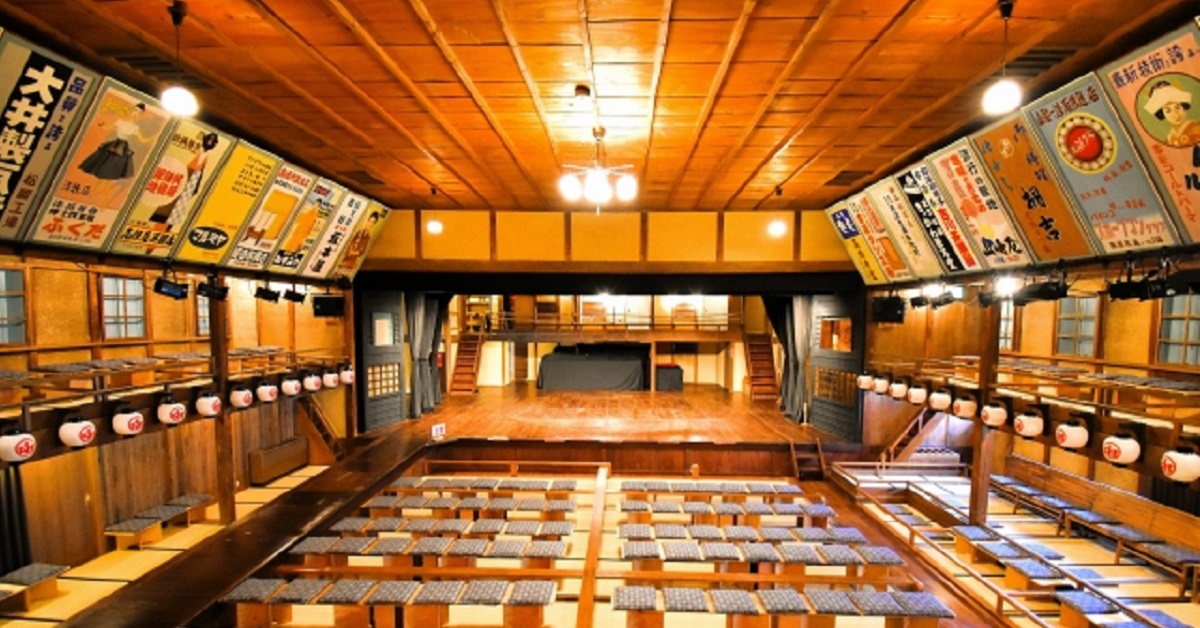Izushi Eirakukan, located in Toyooka City, Hyogo Prefecture, is the oldest surviving playhouse in the Kinki region. Beyond its historical significance, it became an essential stage in the film KOKUHO, where the iconic dance “Futari Fuji Musume” by Kikuo and Shunsuke was performed. Visitors today can step into the same space where art, history, and cinema converge.
The Journey of Izushi Eirakukan
Eirakukan was built in 1901 during the Meiji era. At that time, playhouses were the center of entertainment for ordinary people, hosting kabuki, storytelling, rakugo, and various other performing arts. Although it once closed due to the diversification of entertainment after World War II, it was restored in the Heisei era thanks to the efforts of local residents. Today, it thrives as a venue for theater, traditional performing arts, film screenings, and community events.
During restoration, the builders recreated the structure as faithfully as possible, using original materials and preserving traditional designs. As a result, visitors can experience the atmosphere of a Meiji-era playhouse firsthand.
Architecture and Stage Mechanisms of Eirakukan
This two-story wooden building is equipped with hanamichi (walkway), a revolving stage, the underground naraku, and tatami-floored box seating. The short distance between the stage and the audience allows spectators to feel the actors’ breath and movements—an intimacy rarely found in modern theaters.
| Facility | Feature | Highlight |
|---|---|---|
| Hanamichi | A passageway extending into the audience | The thrill of actors passing right beside the spectators |
| Revolving Stage | Mechanism that rotates the stage | Smooth scene changes |
| Naraku | Space beneath the stage | Supports stage tricks and dramatic entrances |
| Box Seats | Tatami-mat audience seating | A communal and intimate way of enjoying theater |
Such structures are extremely rare today, making Eirakukan an invaluable heritage of Japan’s theatrical history.
The Connection Between the Film KOKUHO and Eirakukan
In the film KOKUHO, Eirakukan is not merely a backdrop but a stage that symbolizes the story itself. The performance of “Futari Fuji Musume” by Kikuo and Shunsuke represents their devotion to their art and embodies the emotional climax of the narrative.
The playhouse’s old wooden construction, combined with the warm stage lighting, added a unique depth to the visuals. As the audience holds its breath, watching the two dance, Eirakukan itself seems to perform as part of the story.
| Character | Role | Scene at Eirakukan |
|---|---|---|
| Kikuo | Protagonist, a performer who dedicates his life to art | Dances “Futari Fuji Musume” as a symbol of mastery |
| Shunsuke | Kikuo’s partner | Performs alongside Kikuo, expressing friendship and artistic bond |
| Audience | Both in-film spectators and real viewers overlap | Share the one-of-a-kind atmosphere of Eirakukan |
Through this portrayal, Eirakukan itself became part of the film, blending history and storytelling in a rare cinematic expression.
Cultural Experiences at Eirakukan
At Eirakukan, visitors are not only audience members; they can step onto the stage, walk the hanamichi, and explore the naraku beneath. These experiences are rarely allowed in modern theaters, leaving unforgettable memories for visitors.
Some performances even involve local children, ensuring that the tradition is passed down to younger generations. Thus, Eirakukan is not just a preserved relic, but a living theater where stage arts continue to thrive.
| Experience | Description | Feature |
|---|---|---|
| Stage Tour | Explore the hanamichi and naraku | Learn the secrets of traditional theater |
| Community Performances | Local residents and students perform on stage | Passing cultural heritage to the next generation |
| Cultural Events | Guided tours of history and architecture | Combine with enjoying Izushi’s townscape |
Harmony Between Izushi Town and Eirakukan
The charm of Eirakukan lies not only in the playhouse itself but also in its harmony with the surrounding town. Izushi is often called the “Little Kyoto of Tajima,” with preserved samurai residences, white-walled merchant houses, and the iconic Shinkoro clock tower. Eirakukan stands at the heart of this historic townscape, blending seamlessly with the atmosphere of bygone days.
Visitors can watch a performance, then stroll through the old streets, enjoy Izushi soba, and explore temples and shrines. In this way, Eirakukan allows travelers to experience both theatrical art and everyday cultural life.
Conclusion
Eirakukan is the oldest playhouse in the Kinki region, holding immense historical value. In the film KOKUHO, it gained new life as a symbolic stage of the story. The scene where Kikuo and Shunsuke perform “Futari Fuji Musume” could only achieve its impact thanks to the unique atmosphere of this traditional playhouse.
Moreover, visitors can enjoy hands-on experiences such as walking the stage, learning stage mechanisms, and exploring the historic town of Izushi. Eirakukan is not only a preserved cultural asset but a living stage that continues to connect past, present, and future through the performing arts.
In the years ahead, this playhouse will continue to offer new inspiration to audiences while sustaining the cultural spirit of the region.






